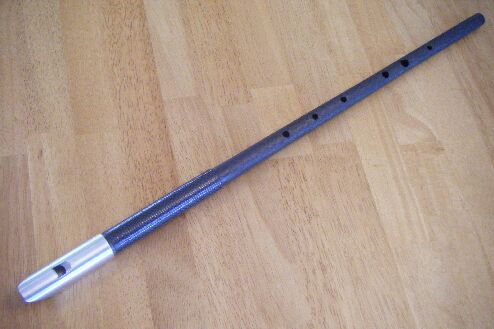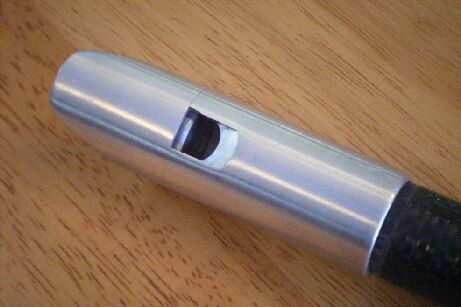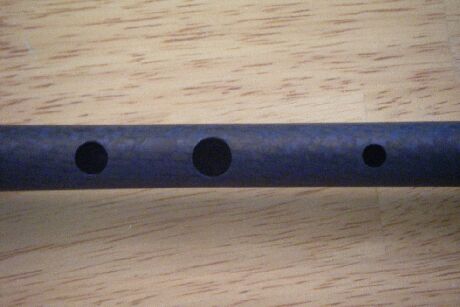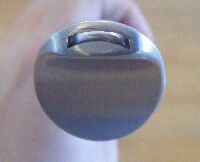Maker - Pipe Makers Union, LLC (Rob Gandara) www.carbony.com
Material - Aluminum, Carbon Fiber
Dimensions: Length - 22 9/16ths"
Distance between 1st and 3rd bottom holes - 2 11/16ths"
Diameter of 2nd hole from bottom - 3/8ths"
Bore - 1/2"
Weight - 3 oz
Price at time of review - $150.00 US direct from Maker
I obtained this whistle on loan as part of a "whistle tour" via the Chiff and Fipple Forum.
Makers often send a new product sample to a list of people for them
to try out and offer feedback. As such I'd like to point out that this
is a proto type whistle.







Appearance:
This is a rather unique looking low whistle, being made from carbon
fiber, which as best as I can tell is just some type of plastic. It
has a catchy, mottled grey and black woven look to the smooth surface
of the body, and has a kind of neck sleeve, which actually is woven and
is bumpy to the touch. The head is aluminum, and has been nicely
hand finished, making a very smooth and comfortable mouth piece.
However, one side of the window appears to be chipped or looks like
they went back in to try and change the window width afterwords. It is
noticeable and takes away from the otherwise very pleasing looks and
clean lines of the rest of the whistle. It features a conical bore, similar
to a Shaw or Copeland, and has fairly small finger holes. The plastic
portion of the whistle is very light, making the whole thing feel a bit
top heavy with the aluminum head, but this is not noticeable when you are playing it. At
first glance I expected the whistle to be tunable by moving the body in
and out of the neck sleeve, but the head actually moves on and off the
end of the neck sleeve, a little loosely I might add.
Tone: Very quiet and very, very breathy, but otherwise pleasant tone. Somewhat reminiscent of a much quieter Chieftain NR. High amount of chiff.
Volume: This is the quietest Low D I've ever played. Would make a good practice whistle. It is slightly louder in second octave than the first.
Backpressure/air requirement: This whistle has fairly low backpressure, but doesn't have a very high air requirement, possibly due to it's small bore size and the fact that you have to blow the bottom octave really softly to keep it from breaking.
Responsiveness: This whistle is fairly responsive with ornaments sounding moderately crisp, clear and snappy. Unfortunately, possibly due to the small size of the finger holes, I couldn't get any kind of finger vibrato to work well or at all on this whistle.
Clogging: This whistle will clog when cold, but not severely, and usually not after it is warmed up.
Tuning: Both the E and A were 20 cents sharp in both octaves. Somewhat surprising is that there is no cross fingering that will even come close to offering up anything resembling a C natural, so you have to half hole it on this whistle.
Sound clip: Inisheer
Summary: I really like the looks and feel of this whistle. If the tuning issues could be taken care of, it would make a great practice whistle, although I would prefer a little more volume and a little less air in the tone. Three holes.

Tone: Very quiet and very, very breathy, but otherwise pleasant tone. Somewhat reminiscent of a much quieter Chieftain NR. High amount of chiff.
Volume: This is the quietest Low D I've ever played. Would make a good practice whistle. It is slightly louder in second octave than the first.
Backpressure/air requirement: This whistle has fairly low backpressure, but doesn't have a very high air requirement, possibly due to it's small bore size and the fact that you have to blow the bottom octave really softly to keep it from breaking.
Responsiveness: This whistle is fairly responsive with ornaments sounding moderately crisp, clear and snappy. Unfortunately, possibly due to the small size of the finger holes, I couldn't get any kind of finger vibrato to work well or at all on this whistle.
Clogging: This whistle will clog when cold, but not severely, and usually not after it is warmed up.
Tuning: Both the E and A were 20 cents sharp in both octaves. Somewhat surprising is that there is no cross fingering that will even come close to offering up anything resembling a C natural, so you have to half hole it on this whistle.
Sound clip: Inisheer
Summary: I really like the looks and feel of this whistle. If the tuning issues could be taken care of, it would make a great practice whistle, although I would prefer a little more volume and a little less air in the tone. Three holes.